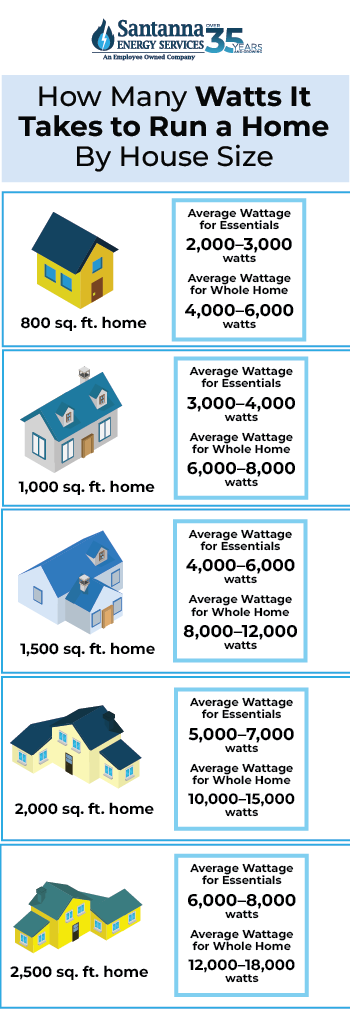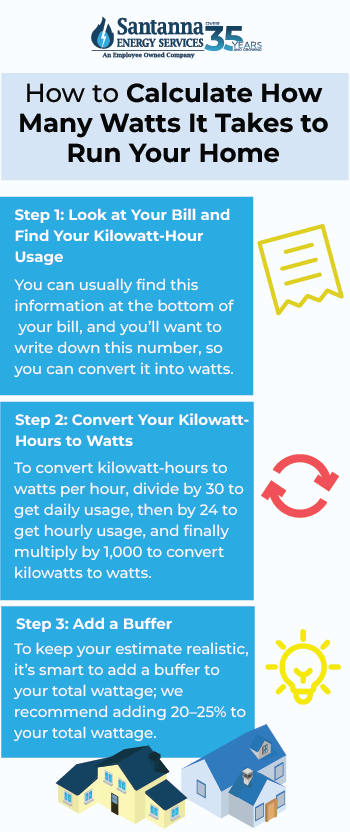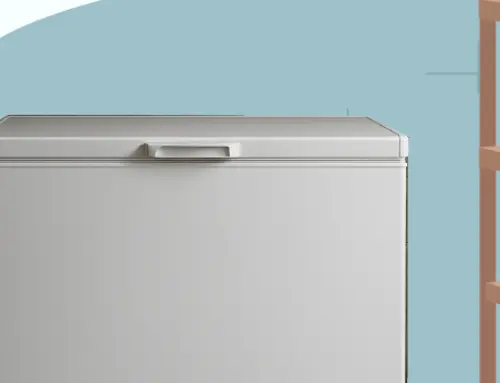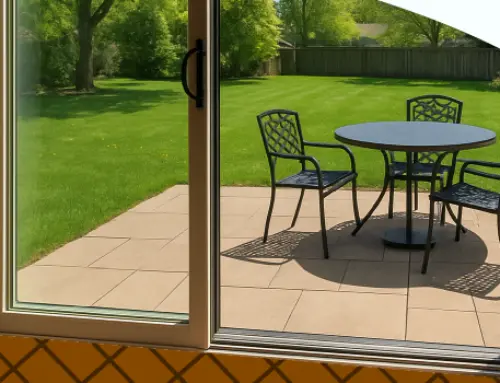How Many Watts Does It Take to Run a House?
by Tyler Castle
15.5 min read

Ever open your electric bill and wonder, "How does it get this high?" You're not imagining things, your home's power use adds up fast. From heating and cooling to every light, appliance, and gadget in between, each watt plays a part.
As an employee-owned energy company serving homes across the Midwest for over 35 years, us at Santanna Energy Services have seen how quickly changing weather and everyday habits can impact electricity use.
In this guide, we'll break down how many watts it really takes to run a house, what drives those seasonal spikes and how to keep your usage in check without giving up comfort. Let's jump in.
Key Points of This Article:
- It typically takes between 5,000 and 8,000 watts to run essential appliances in a house, while a whole-home system may require 15,000 to 20,000 watts or more during peak usage.
- The average U.S. home uses about 1,200 watts of continuous power, based on an annual consumption of around 10,500 kilowatt-hours (kWh), though actual usage varies throughout the day depending on appliances and habits.
- Several factors influence a home’s wattage needs, including home size, number of occupants, appliance types, energy efficiency, climate, and lifestyle, like working from home or using electric vehicles.
- To estimate your own household wattage, you can divide your monthly kWh usage by 30 days, then by 24 hours, and multiply by 1,000 to convert to watts—adding a 20–25% buffer for power surges.
What Are Watts and Why Do They Matter for Your Home?
When you think about electricity in your home, the term watts is one of the most important to understand. A watt (W) is a unit of power that measures how much electricity something is using at a given moment. For example, when a light bulb says "60W," that means it pulls 60 watts of electricity while it's turned on.
What you actually see on your electric bill isn't watts, it's kilowatt-hours (kWh). The utility then multiplies those kWh by your supply rate to calculate the cost. But in this calculation that's relevant to your bills, it all boils down to the beginning with the initial watts of an appliance.
So why do watts matter for your home? Here's how:
- Appliances: Every device in your home, from your fridge to your air conditioner, uses watts when running. The bigger the wattage, the more electricity it draws, and the more you'll need to power your home.
- Bills: Your monthly bill is the sum of all those watts used over time. The more high-wattage appliances you run (and the longer you run them), the higher your kWh, and the higher your bill.
- Energy Planning: Knowing how many watts your home uses is the key to understanding your electricity in general. Once you translate watts into kilowatt-hours (kWh), you can see how much energy your household really consumes. That makes it easier to read your bill, track where your money is going, and decide which energy plan is the best fit.
Think of watts as the "language" your home speaks when it comes to power. Once you understand them, you can translate that into real decisions about your comfort, safety, and ultimately calculate how many watts it takes to run your house.
How Many Watts Are in a Kilowatt-Hour (kWh)?
A kilowatt-hour is the most common unit of measurement you'll see on your electricity bill. It shows how much energy your home has used over time. Think of it like miles on your car, just as miles tell you how far you've traveled, kilowatt-hours tell you how much electricity you've consumed in one hour. We have a guide that explains in more detail how kWh connects to your actual bill here.
For example, if you run a 1,000-watt space heater for 10 hours, that equals 10 kWh of energy. As for another example, if you leave a 100-watt light bulb on for 10 hours, that equals 1 kWh. Okay, one more, a 3,000-watt (3 kW) air conditioner running for 5 hours equals 15 kWh.
Understanding how watts and kilowatt-hours relate helps you read your bill with confidence (you'll know where those numbers come from), spot high-energy appliances that drive costs up, plan smarter when sizing solar systems, generators, or choosing an energy plan.
How Many Watts Does It Take to Run a House?
It takes on average about 1,200 watts of continuous power to keep a typical U.S. home running throughout the day.
Here's how we came to our estimate: According to the U.S. Energy Information Administration (EIA), the average U.S. household uses about 10,500 kilowatt-hours (kWh) of electricity each year. Using the EIA's numbers, 875 kilowatt-hours (kWh) per month works out to about 29 kWh per day.
If we convert that into watts, 29 kWh per day divided across 24 hours comes out to about 1.2 kWh per hour. Since one kilowatt equals 1,000 watts, this equals an average of about 1,200 watts running continuously.
Of course, real usage isn't steady like that. Some hours spike when appliances like the air conditioner or clothes dryer kick on, while other times dip when the house is quiet.
For example, a person working from home in Illinois in a 2,000-square-foot house may run multiple computers, lights, and even the air conditioner during hot summer afternoons. That can push their home's wattage up to 15,000–20,000 watts during peak times.
By comparison, a similar 2,000-square-foot home in Ohio where the residents go into the office during the day may only draw a baseline of 1,200–2,000 watts for the refrigerator, Wi-Fi, and a few lights. Their peak demand still climbs when they're home cooking dinner or doing laundry, but their daily usage pattern looks very different.
Factors That Influence How Many Watts a House Needs
Not every home uses electricity the same way. Two houses right next door to each other could have very different wattage needs depending on their size, appliances, and even the people who live there. If you've ever wondered why your neighbor's electric bill is lower than yours, it often comes down to these key factors:
1. Home Size and Layout
The bigger the home, the more watts it typically takes to power. A 2,000-square-foot home with multiple floors will need far more lighting, larger HVAC systems, and often more appliances compared to an 800-square-foot apartment. Open layouts can sometimes reduce lighting needs, while closed-off rooms may require more fixtures and outlets.
2. Size of Your Household
More people usually means more devices in use. A single person might only run one TV, one computer, and basic kitchen appliances, while a family of five could have multiple TVs, tablets, gaming consoles, and laundry loads each week; all of which increase wattage demand.
3. Number and Type of Appliances
Certain appliances are often called "energy hogs" because they use a large amount of electricity compared to others.
Water heating, lighting, and refrigeration together account for about 25% of total annual home energy use, according to the U.S. Energy Information Administration (EIA). Meanwhile, smaller items like lamps or phone chargers add up but are relatively minor compared to the big systems.
Depending on how many appliances you have and the type, you could be looking at more energy use over time.
4. Seasonal Climate Differences
Where you live has a huge impact. In the Midwest for example, Pennsylvania winters often bring high heating loads, while Illinois summers mean air conditioners run for hours a day. So, the climate around you directly affects how many watts you'll need throughout the year.
5. Energy Efficiency of Appliances
Appliances with an ENERGY STAR® label typically use 10–50% less electricity than standard models. An older refrigerator might use 1,200 watts when running, while a newer efficient one could use closer to 400 watts.
If your home still has older appliances, you could be consuming thousands of extra watts without realizing it.
6. Your House's Age and Condition
Older homes often come with less insulation, drafty windows, and outdated wiring. This means your heating or cooling system has to work harder (and use more watts) to maintain comfort.
Upgrades like double-pane windows, better insulation, and modern HVAC systems can reduce wattage needs significantly.
7. Lifestyle Factors
Your personal habits matter, too. If you work from home, run multiple computers, or charge an electric vehicle (EV) every night, your household wattage will be much higher than someone who works outside the home and only uses a few lights and appliances in the evening.
Even hobbies, like home baking or gaming, can influence how many watts you need on a regular basis.
How Many Watts Does It Take to Run Homes of Different Sizes
The size of your home plays a big role in how many watts you'll need. Smaller homes with fewer appliances naturally use less power, while larger homes with central heating, cooling, and multiple electronics can use several times more.
Climate also matter. A home in the Midwest with hot summers and cold winters will generally need more wattage than the same-sized home in a milder region.
Here's a quick comparison of the estimated typical wattage needs to run a home by size:
Typical Household Wattage Needs by Home Size
| Home Size | Average Wattage for Essentials | Average Wattage for Whole Home |
| 800 sq-ft home | 2,000–3,000 W | 4,000–6,000 W |
| 1000 sq-ft home | 3,000–4,000 W | 6,000–8,000 W |
| 1,500 sq-ft home | 4,000–6,000 W | 8,000–12,000 W |
| 2,000 sq-ft home | 5,000–7,000 W | 10,000–15,000 W |
| 2,500 sq-ft home | 6,000-8,000 W | 12,000-18,000 W |
These are estimates based on the EIA's baseline. We've inflated these estimates to account for multiple appliances in home. Please note these are rough estimates, and your actual wattage may vary.
As you can see from our chart, the bigger the house, the more watts you'll need to power your home. For example, a 1,000 sq-ft home with just the basics (fridge, lights, Wi-Fi, and a small AC unit) may only need around 5,000 watts. But a 2,000 sq-ft home with central air conditioning, a furnace blower, an electric oven, and a dryer could push peak demand up to 20,000 watts or more.

How Appliances Affect How Many Watts It Takes to Run Your House
Every appliance in your home pulls a different amount of power, and some use far more than others.
Your refrigerator, for instance, runs 24/7 but at a steady draw, while an air conditioner or clothes dryer can cause sudden spikes in wattage when they cycle on. Smaller electronics like laptops and TVs may not use much individually, but when added together and run for several hours a day, they can still make a noticeable impact.
This is why two households of the same size can have very different wattage needs depending on the appliances they use and how often they run them. A family with multiple TVs, gaming systems, and a large central AC will use far more watts than someone with only the basics and a few energy-efficient appliances.
Understanding these wattage numbers is a big step toward knowing your total household energy demand, planning for backup power, and making better energy choices.
Here's an estimate of daily wattage and usage times for common household items:
Estimated Daily Appliance Wattage and Usage Time
| Appliance | Power (Watts) | Typical Daily Use Time |
| Ceiling Fan | 60 W | 8 hours |
| Television | 100 W | 6 hours |
| Microwave Oven | 1,000 W | 0.5 hours |
| Air Conditioner | 3,000 W | 8 hours |
| Space Heater | 1,500 W | 8 hours |
| Refrigerator | 500 W | 24 hours |
| Hair Dryer | 1,000 W | 0.5 hours |
| Laptop | 100 W | 10 hours |
| Dishwasher | 1,800 W | 2 hours |
Pro Tip: Actual energy use depends on the appliance's efficiency and how often it's run. For the most accurate assessment of your home's electrical load, consult a licensed electrician.
How to Calculate Your Own Household Wattage
Don't panic; if you're looking to estimate your own wattage, you don't need fancy tools to figure out how many watts your home uses. With your electric bill and a little math, you can get a good estimate. Here's how:
Step 1: Look at Your Bill and Find Your Kilowatt-Hour Usage
Your monthly electric bill will show your usage in kilowatt-hours (kWh). That's the total amount of energy your home consumed during the billing cycle. You can usually find this information at the bottom of your bill, and you'll want to write down this number, so you can convert it into watts.
Step 2: Convert Your Kilowatt-Hours to Watts
Watts measures the rate of electricity use at a given moment, so we need to break down your monthly number of kilowatt-hours into an hourly average. To get this conversion, divide your number of kilowatt-hours by 30 days to get daily usage (since most bills cover about a month of usage).
Then take that number you get and divide it again by 24 hours to spread that daily use evenly across the whole day.
Finally, we multiply by 1,000 to switch kilowatts (kW) into watts (W). So, for example, if your home used 900 kWh last month, dividing that by 30 days gives you 30 kWh per day. Dividing again by 24 hours means your home averages about 1.25 kWh per hour, or 1,250 watts once converted.
In other words, your home's average continuous power draw is roughly the same as running a 1,200-watt space heater all day, every day.
Step 3: Add a Buffer
Not all appliances run smoothly at one wattage. Some need extra energy when they first turn on and some might not. For example, a refrigerator might normally use 200–300 watts but require 600–800 watts for a few seconds at startup. Air conditioners can surge even higher.
To keep your estimate realistic, it's smart to add a buffer to your total wattage; we recommend adding 20–25% to your total wattage. This accounts for those momentary power spikes and helps prevent underestimating your home's needs.

How Many Watts to Run a House on a Generator?
If you want to run your home on a generator, most households need something in the 5,000 to 8,000-watt range. A generator this size provides enough power to cover the essentials that keep daily life comfortable and safe.
That typically includes your refrigerator to keep food cold, a sump pump to protect your basement from flooding, an air conditioner or heater for climate control, lights for visibility, and smaller electronics like a laptop or TV.
Here's a hypothetical example:
A 2,000 sq-ft Ohio home might average about 30 kWh of electricity per day, that's roughly 1,250 running watts on average. But during peak times when central air, a furnace blower, an electric oven, and a dryer are running, total demand can easily surge to 15,000–20,000 watts or more. That's why a smaller 5,000–8,000W generator is better suited for essentials-only use, while a whole-house backup generator usually needs to be in the 15,000–20,000W range.
It's important to remember that not everything in your home uses power the same way appliances like refrigerators and air conditioners have a surge or startup wattage that's higher than their normal running watts. That's why choosing a generator with a little extra capacity is a good idea, so it can handle those spikes without shutting down.
While a 5,000 to 8,000-watt generator may not run every single appliance at once, it gives most homeowners the balance they need between reliability, cost, and convenience during an outage.
How Many Watts Does It Take to Run a House on Solar?
Running a home on solar depends on how much electricity your household uses in a typical day. If your home uses about 875 kWh per month or 29 kWh per day and you get around 4 to 5 peak sun hours, you'd need a system with a capacity of roughly 6,000 to 7,500 watts (6–7.5 kW) to meet that demand. That equals about 15 to 20 solar panels rated at 400W each.
To size a system, compare your daily energy need (kWh/day) to your local peak sun hours. A quick rule of thumb is:
System size (kW) ≈ Daily kWh ÷ Peak sun hours
For 29 kWh/day and 4–5 sun hours, that's about 5.8 to 7.3 kW, and rounding up for losses lands you at ~6–7.5 kW.
Of course, the exact number can vary based on your location, roof space, shading, and energy habits. But this gives you a clear picture of how solar wattage translates into real-world household needs.
FAQs
What's the difference between watts and kilowatt-hours on my bill?
Watts measure the amount of power an appliance is using at a specific moment, while kilowatt-hours measure the total energy used over time. Your electric bill charges you based on kilowatt-hours, not watts, because it reflects your overall consumption across the month.
What's the difference between starting watts and running watts?
Running watts are the steady amount of power an appliance needs to keep operating, while starting watts are the short burst of extra power required when the appliance first turns on.
What's the best time to use electricity?
The best time to use electricity is during off-peak hours, which are usually mornings, late evenings, or weekends. Some utilities charge more during peak hours, such as late afternoon and early evening, so shifting high-energy tasks like laundry or dishwashing can save you money.
What size battery do you need to back up your home?
The battery size you need depends on whether you want to back up only essential appliances or your entire home. For essentials, most households need 10–15 kilowatt-hours of storage, while whole-home backup typically requires 20–40 kilowatt-hours or more.
Is 9,000 watts enough to power a house?
A 9,000-watt system is generally enough to power the essentials in a typical house, such as the refrigerator, sump pump, lights, and a small air conditioner. However, it is not usually enough to run all appliances in a medium to large home at the same time, especially those with high power demands like central HVAC systems, dryers, or electric ovens.
Understanding how many watts it takes to run your home is more than just a technical detail, it's the foundation for smarter energy decisions. By knowing your wattage needs, you can read your bills with confidence, plan for backup power, and decide whether solar is a good fit for your household.
For Midwest homeowners, this knowledge is even more valuable. Seasonal swings, like heavy heating loads in the winter and high air-conditioning use in the summer, can cause big fluctuations in energy demand. Planning ahead helps you stay prepared for both everyday living and unexpected outages.
With Santanna's Unlimited Energy Plan, you get predictability all year long, no matter how much energy you use.* It's the simple way to turn energy awareness into peace of mind.
* Restrictions apply. Enrollment based upon program eligibility. Customers using more than 125% of normal monthly usage as determined by Santanna may be required to switch plans.
Tyler is an experienced energy professional, having worked for Santanna Energy Services, for the past four years. He is passionate about renewable energy and believes that diversifying the energy grid is the key to a sustainable future. Tyler is dedicated to supplying consumers with the best possible energy solutions and works diligently to make sure that Santanna can deliver the highest quality service.







